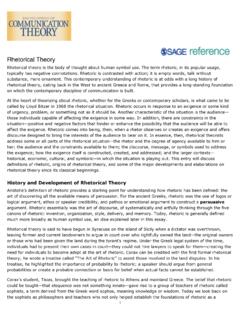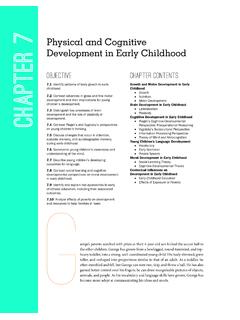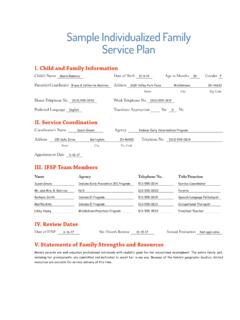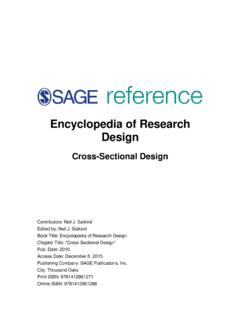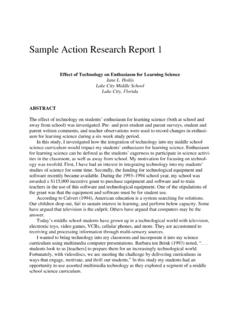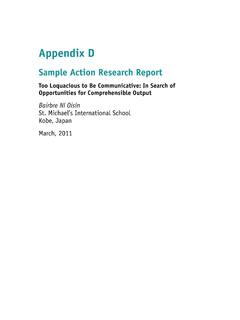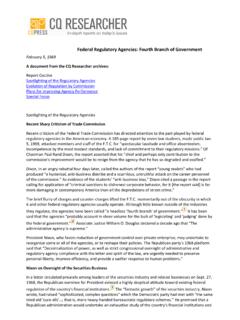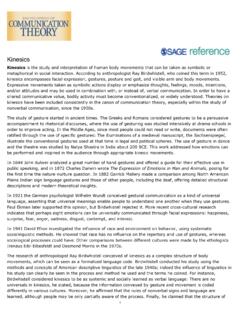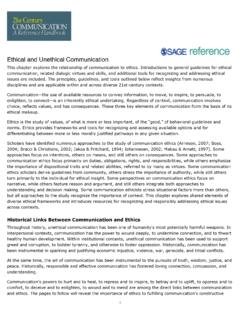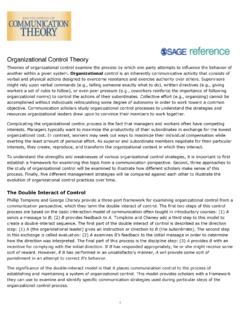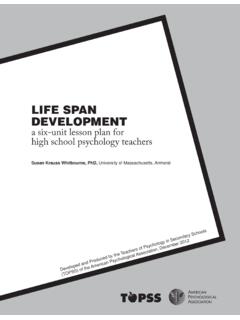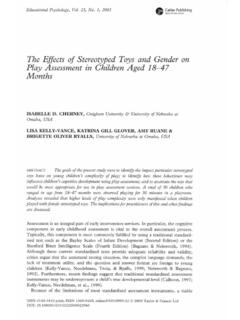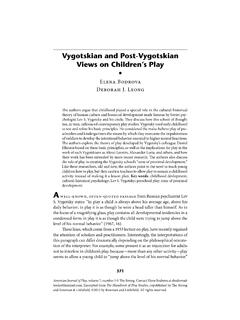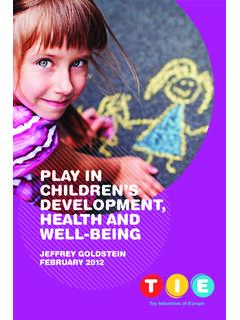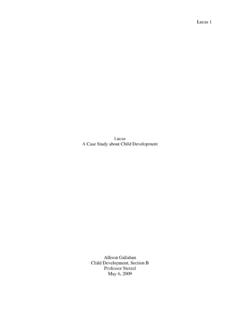Transcription of Introduction to Child Development - Online Resources
1 1 Introduction to Child Development1 Why you should read this chapterThis book focuses on the study of Child Development from birth to 8 years. From our own observations of children, we are all aware of the tremendous changes that take place during this period: in the space of a few years, not only do children grow in the physical sense, they also acquire skills in language and communication, the capacity to think and reason about the world, and skills in social interaction. The study of Child Development is not just fascinating in its own right; knowledge gained from studying Development can also impact on many practical issues regarding the care, education and wellbeing of children. This book presents an overview of research and theory in various aspects of Child Development , but before we look at these, this chapter and Chapters 2 and 3 will aim to provide some basic context for the study of Development as a whole.
2 In this chapter we will look at some basic issues in Child Development and some of the broad theoretical approaches to understanding Development .(Continued) 112/18/2013 3:49:53 PM2 Child Development : A Practical IntroductionBy the end of this chapter you should be aware of the various domains of Development that are of interest to researchers in this field understand some basic issues in the study of Development including the role of nature versus nurture, and whether Development proceeds in a continuous or discontinuous manner be aware of the different theoretical approaches to Development including psychoanalytic, learning theory, cognitive-developmental, ethological and evo-lutionary psychology , and bioecological approaches have a basic understanding of some specific theories from the various nature of developmentDevelopment can be seen as the way in which individuals grow and change over the course of their lifespan and this can take place in different domains.
3 Biological, which includes features such as physical growth and developments in motor skills; cognitive, which refers to changes in thought processes such as memory, reasoning and problem solving, imagination, and creativity and language; emotional, where the focus is on changes in emotional experience and understanding; and social, which refers to changes in our understanding of ourselves and other people and how we relate to others. While the division of Development into different domains may be useful from the point of organising our own thinking about the nature of Development , it is impor-tant also to recognise that Development itself is a holistic process and each domain influences and is influenced by the others. For example, Development in a Child s motor skills, such as crawling and reaching and grasping (physical Development ), will allow them to explore both their environment and the objects in this environment, leading to a greater understanding of their surroundings (cognitive Development ).
4 A central issue in Development is the nature versus nurture debate, in other words, the relative roles played by biological and genetic factors as opposed to envi-ronmental factors in shaping Development . Nature refers to the role of biology and genetics and nurture to the role of experience and other environmental factors. Advocates of the nature position see Development as a process of maturation, with physical and psychological change unfolding according to a genetically predetermined plan inherited from our parents. The nurture viewpoint sees Development occurring as a result of learning. Hall (1883) was a strong proponent of the role of nature in Development , and very much influenced by evolutionary theory. This can be seen in (Continued) 212/18/2013 3:49:54 PM Introduction to Child Development 3his theory of play , in which he argued that children s play emerged in a way that reflected the evolutionary history of the human species.
5 For Hall, children s play was essentially acting out this history, for example an infant crawling reflected a point in human evolution when humans walked on all fours. On the other hand, Watson (1930) took the view that environmental experiences and learning were of most importance and claimed that he could use the environment to shape the Development of any Child : Give me a dozen healthy infants, well-formed and my own specified world to bring them up in, and I ll guarantee to take any one at random and train him to become any type of specialist I might select doctor, lawyer, artist, merchant-chief, and yes, even beggar-man and thief, regardless of his talents, penchants, tendencies, abilities, vocations and race of his ancestors. (Watson, 1930: 104) Watson s views on the role of the environment will be covered later in this , most theorists do not take a rigid position on the role of nature and nurture and see Development occurring through the interplay of both factors.
6 For example, it is widely accepted that babies are born with different temperaments which can be classed as easy or difficult , and there is likely to be an inherited basis for either. However, research by Thomas and Chess (1986) has also indicated that the nature of the parenting received by babies is also important in the long-term Development of temperament and a difficult baby will not necessarily grow into a difficult Child or adult. Sensitive caregiving can alter the temperament of the Child . Another interesting issue is the extent to which abilities and behaviour are canalised (Waddington, 1975), in other words, are strongly influenced by genetic factors, or are amenable to environmental influences. The Development of motor skills in infants would be an example of a strongly canalised process, as all infants will eventually roll over, reach for objects, sit up, crawl and walk, and it would take extreme circumstances to alter this pattern.
7 On the other hand, personality characteristics such as temperament and intelligence, while having a genetic component, are seen as less strongly canalised and can be altered by the environment in which the infant is raised. Another aspect of Development that has been subject to debate is whether it pro-ceeds in a continuous or discontinuous manner. Continuous Development implies a gradual but smooth pattern of change over time. Essentially, babies and children are seen as having the same basic capacities as adults and changes take place in the effi-ciency and complexity of their abilities until they reach the mature, adult levels. Change is then essentially quantitative in nature. Just as children grow taller and can run faster as they get older, their psychological characteristics also change in the same way, for example they can remember more and their thought processes become more complex and sophisticated.
8 The alternative discontinuous view is that Development proceeds as a series of abrupt changes and with each change the Child moves to a more advanced level of functioning. In this view, the Child moves through a series of developmental stages, and with each new stage the Child s behaviour, abilities or thought processes are qualitatively different to what they were in the preceding 312/18/2013 3:49:54 PM4 Child Development : A Practical IntroductionTheories of developmentA theory is essentially a set of organised observations that are used to explain an inter-esting phenomenon. There are a number of broad theories of Child Development and some of these will be reviewed in this section. These will include psychodynamic, learning, cognitive-developmental, ethology and evolutionary psychology , and bioeco-logical theories.
9 Psychodynamic theoriesPsychodynamic theories have their roots in the work of Sigmund Freud whose views stemmed from his experiences of treating individuals suffering from a variety of neuroses. Freud concluded that human Development is essentially driven by conflict. We have basic aggressive and sexual instincts that need to be satisfied, but we live in a society where such instincts have to be controlled and restrained. Development was therefore about seeking a balance between satisfying basic drives and adapting to the reality of our situ-ation. Freud (1917) proposed that the human personality is made up of three compo-nents: the id, the ego and the superego. The id is present from birth and its sole purpose is the satisfaction of our basic urges. It operates according to the pleasure principle and seeks immediate gratification of our needs and Freud believed that the infant was dominated by it.
10 However, as we develop, our instincts come into conflict with reality and we need to restrain the impulses of the id, and this leads to the emergence of the ego. The ego operates according to the reality principle in that it seeks to satisfy our basic drives but in a desirable and socially acceptable manner. The final component we develop is the superego and this occurs during the preschool years when children take on their parent s moral values as their own. The superego acts as the Child s con-science and allows them to know when they have done wrong without the need to be told by an adult, thus they are enabled to feel guilt and shame over their unacceptable conduct. Freud viewed healthy Development as achieving a balance between the three conflicting components of personality. The id communicates basic needs, the superego demands that we behave in a morally acceptable manner and the ego attempts to satisfy the demands of the id but in ways that are acceptable to the superego.
